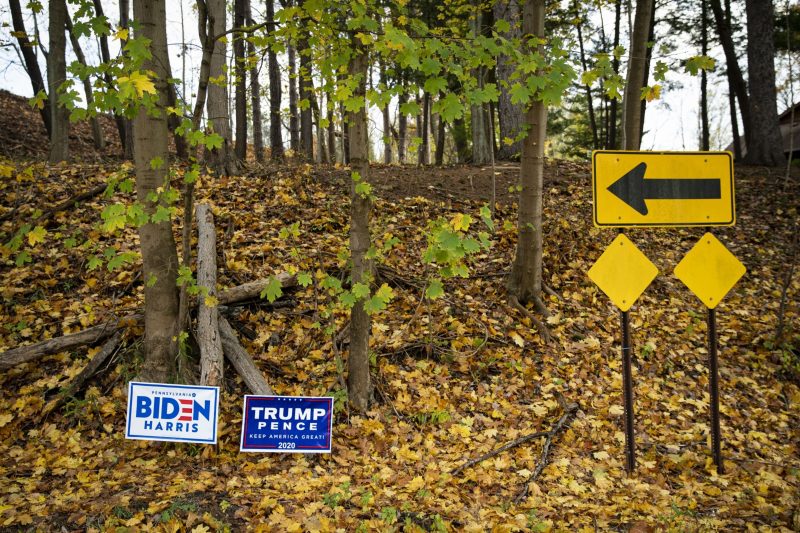One of the unusual dynamics of the 2016 presidential race was that neither candidate was particularly well-liked. Donald Trump and Hillary Clinton were viewed more unfavorably than favorably by Election Day, with perceptions of each candidate at historic lows.
Seven years later, though, this seems almost unremarkable. National politics have been mired in toxicity for so long that it’s sort of hard to imagine a contest in which voters were choosing between two candidates that they liked, rather than picking the least undesirable option.
But this is where we are. Meaning that one of the most interesting questions about the 2024 contest — one that will by all appearances feature a rematch of the one three years ago — is how those Americans who view both candidates unfavorably will vote.
After all, they made the difference in 2016.
Not nationally, mind you. Exit polling showed that about a fifth of voters who cast ballots in 2016 viewed both candidates unfavorably. Let’s call them the “haters.” Within that 18 percent, Trump got just under 50 percent of the vote, a 17-point advantage over Clinton.
This pattern trickled down into the states. In Michigan, Pennsylvania and Wisconsin, which Trump flipped from Democratic victories in 2012, about a fifth of voters viewed both Trump and Clinton unfavorably. Trump won majorities of those voters in each state.
That was important! Had all of those haters stayed home, exit polling suggests that Clinton would have won Michigan, Pennsylvania and Wisconsin — and the presidency. But they didn’t.
In 2020, the dynamics were different. Trump was still unpopular but Joe Biden wasn’t. By Election Day, only 3 percent of voters indicated that they viewed both candidates negatively. Trump still won that vote nationally and in the swing states of Georgia and Wisconsin, according to exit polls.
Why don’t we know who won the vote in the other states that flipped from red to blue in 2020? Because there simply weren’t enough members of the hater voting bloc to break out their results. It’s a useful point to remember that exit polls are broad estimates of who voted and how, and that the more precision you seek by picking out narrower demographic groups, the less precise they become. The relatively small hater bloc, though, was also a function of Biden having generally positive ratings from voters — a situation that has changed in the subsequent three years.
Because there were far fewer haters, the effects of their preference for Trump was more muted. In neither Georgia nor Wisconsin did they swing things for Trump — obviously, since he lost both.
So now the questions become “how many haters will there be in 2024” and “how will they vote?” Polling released from Quinnipiac University on Wednesday offers an early estimate.
Very early, obviously. We don’t even know who the major-party nominees will be (though we can guess) and lots of things can change between now and the election that will occur a year from now. We have a recent example of this; in November 2019, did you expect 2020 to center heavily on a global viral outbreak? But with those qualifiers stated, the Quinnipiac poll is still useful.
At this point, the school’s polling finds that about 4 in 10 Americans view Biden and Trump favorably. As you’d expect, that’s centered heavily within members of each candidate’s party; most independents view both men unfavorably. (Independents often lean their support toward one party or the other not because they like that party more — they’d just join the party if they did! — but because they dislike the other one.) Overall, only 2 percent of respondents view both candidates favorably. Seventeen percent view both unfavorably.
There’s a trick to comparing polling before the election with polls taken after people vote: many of those who respond to Quinnipiac’s poll won’t cast a ballot. Among those who say they like neither candidate, for example, 1 in 8 say they won’t vote in 2024. Among those who have a vote preference (about 4 in 5 respondents), Biden has a narrow, nonsignificant advantage.
But there’s a twist in 2024: Robert F. Kennedy Jr. and Cornel West are running independent candidacies. There are systemic challenges to this; both candidates will have a challenge in getting on the ballot in every state. Quinnipiac included Kennedy in a 2024 preference question anyway, finding that he drew significant support from both candidates. And, among haters with a vote preference, he was the runaway winner.
Again, this will change. About 3 in 10 respondents don’t have an opinion of Kennedy. If they form one over the next year, those opinions may not be favorable, meaning that the haters are again left without someone they view particularly positively. As the polling stands, though, it suggests a possibility that neither major-party candidate might benefit substantially from the hater vote.
Kennedy’s candidacy disrupts the advantage that Trump had in 2016. He was the candidate of disruption, of upending the way things worked. If you held a cynical view of both candidates, you might also have a cynical view of politics in general, meaning that you might lean toward a candidate who — even if you didn’t like him — promised to break the system. In 2024, those same voters might view the new outsider, Kennedy, as the conduit for rearranging how Washington works. Just as Biden’s favorability has constricted following his tenure in office, Trump’s ability to position himself as an outsider is likely to have declined.
There remain a lot of people who dislike both major-party candidates. It’s unusually unclear, though, whether their views will help decide who becomes president in January 2025.

